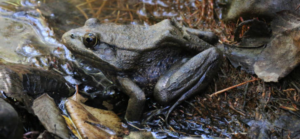 California red-legged frog
California red-legged frog
courtesy of the U.S. Fish and Wildlife Service
In my last blog, I addressed how the United States Fish and Wildlife Service (FWS) has neglected to undertake the plan that it announced in early 2016 to finalize and improve its weak “interim” regulation aimed at preventing the salamander disease “Bsal” (Batrachochytrium salamandrivorans) from infecting salamanders in the still-unexposed United States. While Canada, the European Union and the United Kingdom have all taken very strong measures this year to block salamander imports that are not “Bsal free,” our country is stuck on a much weaker approach that I described as “Swiss cheese”.
Further compounding my concern about FWS’s inaction is new science about Bsal’s older devastating cousin, “Bd” (Batrachochytrium dendrobatidis), the separate fungus epidemic that has extirpated huge numbers of frogs and toads worldwide, driving several species extinct. Within the last year, the FWS has secretly withdrawn its consideration of a formal petition to regulate Bd filed with the Secretary of the Interior (in charge of the FWS) by Defenders of Wildlife in 2009. The Petition set out a plan to block the ongoing risk to native frogs and toads that the Bd pathogen posed then – and still poses. See description and documents under “Chytrid Fungus – September 16, 2010” here. The petition requested the FWS to create a “Clean Trade” program for shipments of imports, keeping them out of the country unless accompanied by certification that they are “Bd free” – whether by quarantine, testing or other reliable certification approach.
The new key paper, published last month in Science, is a sweeping study that finally answers the two questions that bedevilled amphibian experts since Bd’s first identification back in the mid-1990s: where did it come from and how was it spread around the world? O’Hanlon et al.’s study, “Recent Asian origin of chytrid fungi causing global amphibian declines,” here, [one must have an account to read the article] was extremely complex (there were 59 co-authors!). They discovered that Bd originated in salamanders in Asia, likely on the Korean Peninsula, and was spread via trade in live frogs and toads (pets, specialty foods and perhaps other uses). Genetic analysis of the numerous Bd strains showed there is still potential for more strains to mix, for new hybrids to emerge and for still more virulent outbreaks of the disease to occur. The article states: “… further sampling across this region is urgently needed because the substantial global trade in Asian amphibians presents a risk of seeding future outbreak lineages.” One lead co-author, Professor Matthew Fisher of Imperial College London, told the BBC:
“Until the ongoing trade in infected amphibians is halted, we will continue to put our irreplaceable global amphibian biodiversity recklessly at risk.”
Also notable is University of Maryland Professor Karen Lips’ concise commentary on it here [one must have an account to read the article]. Dr. Lips links the lessons of Bd and Bsal, pointing out the obvious: regulators need to learn the tragic lessons of Bd and take steps to keep out Bsal now – and not wait until after the fact of an outbreak.
Perhaps it was understandable before the O’Hanlon et al. paper that the FWS never responded to the Defenders of Wildlife Bd petition seeking trade restrictions because Bd was already so widespread within the United States then (unlike Bsal) and Bd’s origins and genetics were so confusing. It was not entirely clear that regulating further amphibian imports would have actually improved our level of Bd protection. But, O’Hanlon et al. changes that –– we now know enough to justify much stricter regulation to prevent more imports of Bd-infected frogs and toads and to block the potential for more virulent outbreaks here.
In short, FWS action on that 2009 Defenders of Wildlife petition is called for now. (Disclaimer: I wrote and filed that petition when I was Director of International Conservation at Defenders.) However, in a remarkably unfortunate use of its administrative powers, the FWS internally determined in March of 2017 to just altogether stop considering it. Rather than communicating back to Defenders that it is granting or denying its petition the FWS now states that it has “Withdrawn” consideration of any regulatory action, here.
This move by FWS plainly is part of the Trump Administration’s broad de-regulatory agenda. But, the FWS made no decision other than to put it on hold and Defenders of Wildlife did not withdraw it, so as a legal matter the nine-year old Petition is still pending. The FWS can and should take it up again and grant it. But, Defenders likely will have to push hard in order for that to happen.
The scientific community working on both Bd and Bsal has produced authoritative, painstaking studies on which the FWS and others can rely in regulating. And the community has made clear calls to stop the ongoing trade in many scores of species of amphibians around the world with no quarantines or health certificates, which is “business as usual” now. If the amphibian trade continues in the future it needs to be Clean Trade or we will suffer further consequences. It is up to us in the conservation community to convert the scientists’ calls into regulatory reality.
Posted by Peter Jenkins
We welcome comments that supplement or correct factual information, suggest new approaches, or promote thoughtful consideration. We post comments that disagree with us — but not those we judge to be not civil or inflammatory.